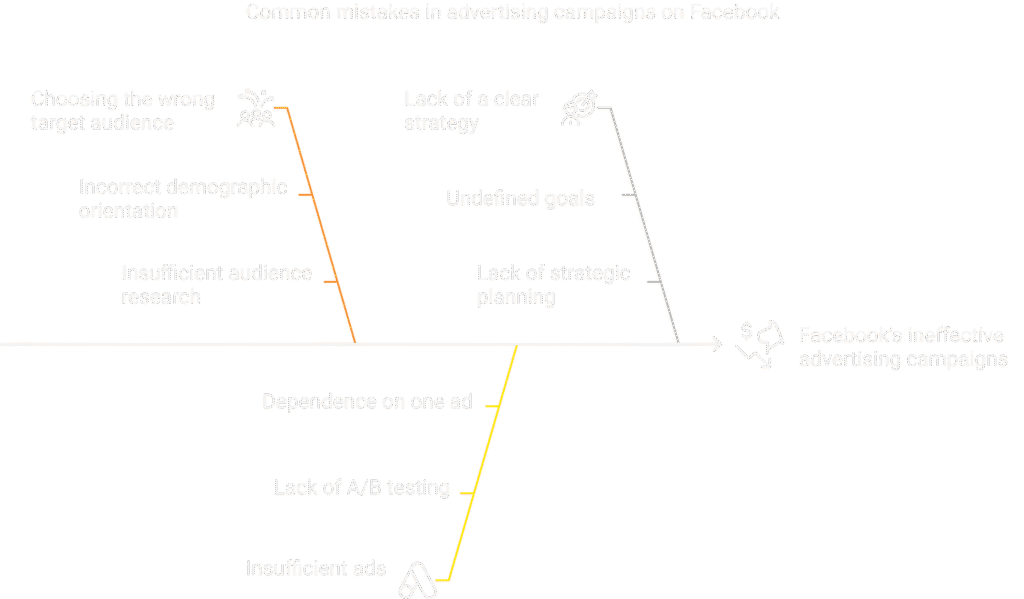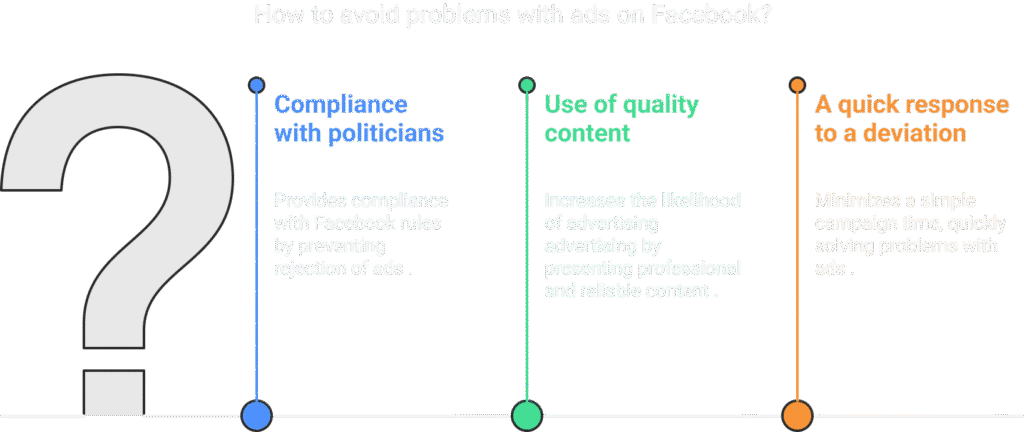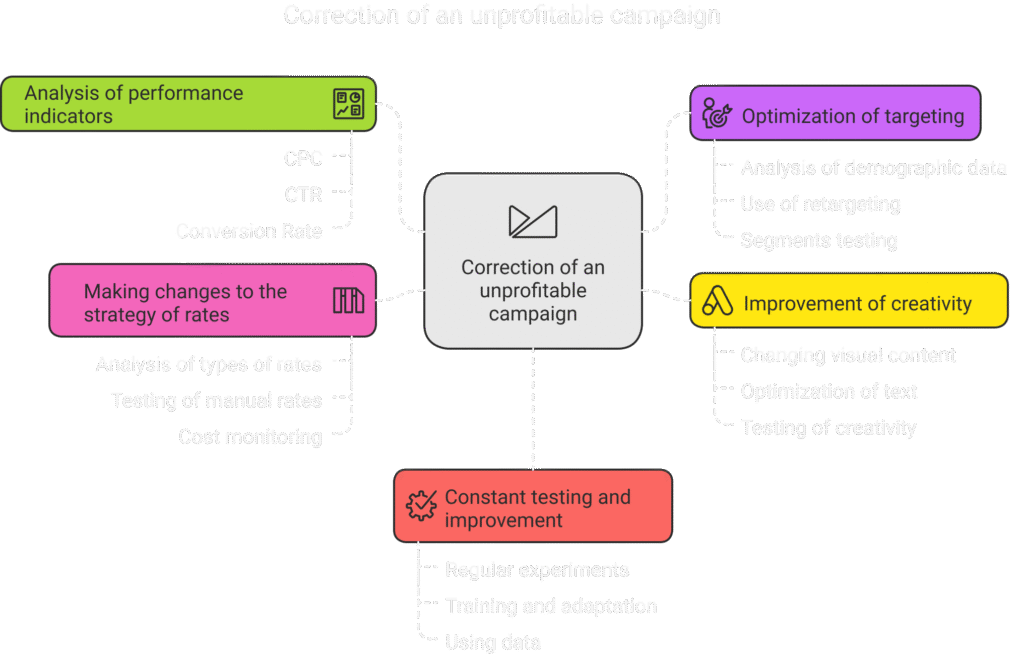Facebook advertising mistakes to avoid

- The most common mistakes when launching campaigns
- Choosing the wrong target audience
- Insufficient ad testing
- Lack of a clear strategy
- How to avoid problems with ad moderation
- Compliance with Facebook policies
- Using quality content
- Rapid response to deviations
- How to fix an unprofitable campaign
- Analysis of key performance indicators
- Targeting and budget optimization
- Improving creativity
Facebook advertising is one of the most powerful tools for attracting customers and scaling your business. But even the most experienced marketers are not immune to mistakes that can lead to wasted budget, low campaign performance, and lost potential customers.
Often, businesses launch Facebook ads, spend hundreds or even thousands of dollars, but don’t get the results they want. Why does this happen? Most often, it’s the result of common mistakes: incorrect audience selection, ineffective creatives, incorrect bid settings, or lack of in-depth analysis of metrics.
In this guide, we’ll look at the most common Facebook advertising mistakes made by both beginners and experienced marketers. And most importantly, we’ll tell you how to avoid them and make your advertising more effective.
1. The most common mistakes when launching campaigns

Choosing the wrong target audience
One of the most common mistakes is choosing the wrong target audience. Even the best advertising won’t bring results if it’s not targeted to the right people.
“Precise targeting is the key to success in Facebook advertising. An inappropriate audience is doomed to low conversion and high costs.”
How to avoid:
- Market research. Before launching a campaign, it is important to conduct a thorough analysis of your audience. Determine who your potential customers are, what their interests are, their age, and their location.
- Using Lookalike Audiences. Facebook allows you to create Lookalike Audiences based on your existing customers. This is an effective way to reach new people with similar characteristics.
- Test different segments. Try setting up multiple audience segments and analyzing their performance. Your ideal audience may be completely different than you expected.
Insufficient ad testing
The second common mistake is launching an advertising campaign without prior testing. Often, advertisers create one ad and expect big results from it.
Example:A brand launched a campaign with a single video but wasn’t getting the results they were hoping for. When they created multiple variations with different visuals, engagement levels increased significantly.
How to avoid:
- A/B testing. Create multiple ad variations with different images, text, and headlines. This will allow you to determine which ad performs best.
- Monitoring and analysis. Constantly monitor the effectiveness of different ads and adjust them as you go. The faster you react to an ineffective ad, the less money will be wasted.
Lack of a clear strategy
Without a clear strategy, your Facebook advertising efforts may be in vain. An advertising campaign should have specific goals that can be achieved.
“Advertising without a strategy is like a boat without a compass. You don’t know where you’re going, and that almost always leads to failure.”
How to avoid:
- Set goals. Determine what you want to achieve – whether it’s increasing brand awareness, attracting new customers, or increasing sales. Each goal requires a different approach.
- Campaign planning: Create a plan that includes ad types, budgets, delivery schedule, and performance metrics. This will help you track your progress and make adjustments as needed.
2. How to avoid problems with ad moderation

Compliance with Facebook policies
One of the most common issues advertisers face is having their ads blocked for violating Facebook’s policies. Ad moderation is automatic, and any deviation from the established rules can lead to your ad being disapproved.
“Adhering to policies is the first step to a successful advertising campaign. Even the most creative advertising will be useless if it does not comply with the platform’s rules.”
How to avoid:
- Review policies: Before creating an ad, be sure to review Facebook’s current advertising policies. This will help you avoid common mistakes, such as using prohibited images or text.
- Content review: Carefully review all ad content, including text, images, and videos, for compliance with our policies. Avoid using provocative content, misinformation, or exaggeration.
- Use pre-screening tools. Facebook offers tools that allow you to review your ads before they go live. This helps identify potential issues early.
Using quality content
Content quality plays a key role in ad moderation. Low-quality or misleading content can lead to disapproval.
Example:An advertiser who used low-quality images with a lot of text repeatedly had his ads disapproved. After changing the content to professional photos with clear text, his ads were moderated without any problems.
How to avoid:
- Professional quality images and videos. Make sure all visuals meet high quality standards. Avoid images with low resolution or large amounts of text.
- Clear and authentic texts. The text of the ad should be clear and truthful. Avoid exaggerations and attempts to create a misleading impression on the user.
- Content testing: Before launching your ads, test your content with a small group of your audience. This will help you identify potential issues and make any necessary adjustments.
Rapid response to deviations
Despite your best efforts, sometimes your ads may be disapproved. It’s important to know what to do in these cases to minimize campaign downtime.
“Refusal of moderation is not the end. The main thing is to quickly understand the reason and make the necessary changes.”
How to avoid delays:
- Analyze the reasons for the disapproval. Carefully read the disapproval message that Facebook sent you. This will help you understand what changes you need to make to your ad.
- Make changes quickly. Make any necessary adjustments to your content and resubmit your ad for moderation. If you believe the rejection was in error, use the opportunity to appeal.
- Constant monitoring. Regularly check the status of your ads to be sure they are active. This will allow you to respond quickly to any problems.
3. How to fix an unprofitable campaign
Launching a Facebook advertising campaign is just the beginning. It doesn’t always produce the expected results the first time. It often requires adjustments to make the campaign profitable. In this section, we’ll look at how to analyze and optimize your campaign for better results.

Performance analysis
The first thing you need to do when you notice that your campaign is not producing the expected results is to analyze its metrics. Facebook Ads Manager provides detailed information about the performance of each ad.
“Data is the foundation for making informed decisions. Without analysis, you act randomly.”
Key indicators:
- CPC (Cost Per Click) – cost per click. If this indicator is too high, you may need to change your targeting or creative.
- CTR (Click-Through Rate) – the percentage of users who clicked on an ad. A low CTR may indicate that the content is not relevant to the target audience.
- Conversion Rate – the percentage of users who completed the desired action after clicking on an ad. A low rate may indicate problems with the landing page.
Targeting optimization
Targeting is a key element of campaign effectiveness. If your ad is shown to the wrong audience, even the best creative won’t deliver results.
Example:A campaign that targeted too broad an audience had a low CTR. After narrowing the audience based on interests and behavior, the results improved significantly.
How to optimize:
- Demographic analysis: See which audience segments are engaging with your ad the most and focus on them.
- Use retargeting: Create separate campaigns for users who have already interacted with your site or previous ads.
- Test different segments: Conduct A/B testing to determine which audience segments respond best to your ads.
Improving creativity
Sometimes the problem may not be with your targeting, but with your creative itself. Your ad may not be engaging or conveying a clear message.
“Creative is what defines the first impression. If it doesn’t appeal, the audience won’t be interested.”
How to improve:
- Vary your visual content. Try different formats – videos, carousels, slideshows. Professionally created visuals often work better.
- Text optimization: Keep your text short, clear, and engaging. Avoid generic phrases and use specific calls to action instead.
- Creative testing: Run multiple ad variations with different content and analyze which one performs best.
Making changes to your betting strategy
Choosing the right bidding strategy can make a big difference in your campaign’s performance. Sometimes you need to rethink how you bid to lower your costs and increase your profitability.
Example:A campaign using automatic bidding had a high CPC. After switching to manual bidding and setting limits, costs decreased and performance increased.
How to make changes:
- Analyze bid types: See which bidding strategy is best suited to your goal, such as optimizing for clicks or conversions.
- Test manual bids: If automatic bids aren’t working, try setting manual bid limits.
- Monitor costs: Regularly review costs and adjust rates to ensure optimal use of your budget.
Continuous testing and improvement
Facebook advertising is a dynamic process that requires constant testing and improvement. Successful advertisers regularly experiment with new ideas and analyze the results.
“The secret to success in advertising is constant testing and adaptation. What works today may not work tomorrow.”
How to succeed:
- Experiment regularly. Try new ideas, formats, and approaches. This will help you find new effective methods.
- Learn and adapt. Stay on top of new advertising trends and adapt your campaigns to changes in user behavior.
- Using data to make decisions. Constantly analyze data and adjust your strategies based on the results.
By applying these recommendations, you can avoid the most common mistakes and turn an unprofitable campaign into a successful one that brings stable results.



